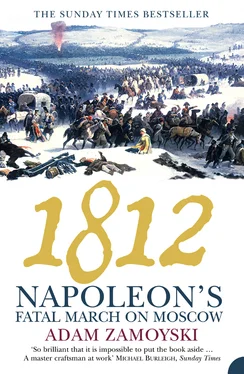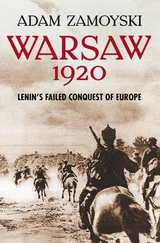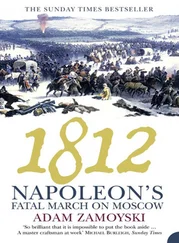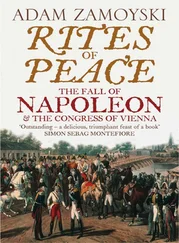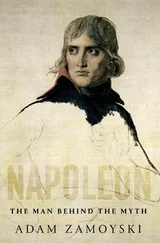Soon the whole of Germany was covered in troops marching eastwards and northwards. There were files of cavalry: cuirassiers in helmets and breastplates, chasseurs in green uniforms and bearskin kolpaks , lancers in blue and crimson with four-cornered Polish caps, dragoons in helmets and uniforms of every hue. There were long convoys of artillery, in lighter blue with black shakos. And above all, endless columns of infantry.
The French footsoldier wore a standard cutaway blue coat, white breeches or trousers, white or black gaiters and a shako or a bearskin bonnet. It was not a uniform designed for convenience, let alone comfort. ‘I have never understood why under Napoleon, when we were constantly at war, the soldier should have been forced to wear the ghastly breeches, which, by pressing in on the hams at the back of the knee, prevented him from walking easily,’ wrote Lieutenant Blaze de Bury. ‘On top of that, the knee, which was covered by a long buttoned-up gaiter, was further strangled by another garter which pressed on the garter of the breeches. Underneath, the long undergarment, held in place with a cord, further restricted the movement of the knee. It was, all in all, a conspiracy by three thicknesses of cloth, two rows of buttons one on top of the other, and three garters to paralyse the efforts of the bravest of marchers.’ He wore shoes with unfashionably square toes – to prevent theft or the resale of military shoes to civilians. These shoes were supposed to last for a thousand kilometres of march, but usually fell apart far sooner. 36
Every footsoldier carried a heavy musket 1.54 metres long without its bayonet – taller than Napoleon. On a bandolier slung across his shoulder he carried his giberne , a stiff leather case containing two packets of cartridges, a phial of oil, a screwdriver and other gun-cleaning implements. On his back he carried a pack made of stiffened cowhide, in which he carried a couple of shirts, collars, kerchiefs, canvas gaiters, cotton stockings, a spare pair of shoes, a sewing kit, clothes brush, pipeclay and bootwax, as well as a supply of hard tack, flour and bread. His rolled-up overcoat and other items of kit were strapped to the top of the backpack.
Most of the ornamental features of the uniform were absent on the march. Shakos and bearskins disappeared into oilcloth covers and strapped to the backpack or hung off it, plumes were put away in waxed canvas containers which were strapped to the swordbelt or bandolier. In their place the men donned the bonnet de police , a flat forage cap with a tasselled bob hanging down the side. Breeches and gaiters were replaced by baggy canvas trousers, and the Old Guard wore long blue tunics instead of their white-faced uniforms.
The men marched at the pas ordinaire , of seventy-six steps a minute, or the pas accéléré , of a hundred steps a minute. A usual day’s march was between fifteen and thirty-five kilometres, but in a forced march they could cover anything up to fifty-five kilometres. Every unit, every horse, every man had a route prescribed for them, was instructed where to stop for the night and provided with food and accommodation. On arrival at a given stop, the unit’s farrier or some other non-commissioned officer would go to the local military commander or commissaire des guerres and collect a visa from him. He would then take this to the town hall, where he would be given a full list of billets for the men, and chits for forage and victuals. These chits were then taken to the appointed provisioning merchants, and the unit would collect its supplies for that evening and the next day. The system worked like clockwork in France and Germany, with the required supplies ready and waiting for the tired men when they reached their prescribed halt. 37
There were nevertheless jams of horses, cannon and wagons of every description, of straggling men and single platoons as well as large units snaking along over several miles of road, of officers in private carriages hurrying to join their units, and couriers trying to gallop in both directions, particularly at the crossings over the Rhine, at Wesel, Cologne, Bonn, Coblenz and Mainz.
Those still in Paris tried to make the most of what was a particularly glittering carnival, and the Comte de Lignières, Lieutenant in the Chasseurs of the Guard, found his order to march out when he returned to barracks at four in the morning after a ball. The notaries of Paris were kept busy writing wills, and some followed the departing troops, along with wives and lovers who wanted to see their dear ones for a few days longer. 38
The Army of Italy came over the Brenner pass and down into the valley of the Danube, where it met up with the contingent from Bavaria. ‘Our march was like a brilliant and agreeable military promenade,’ noted Cesare de Laugier, a native of Elba. Lieutenant von Meerheimb found leavetaking from his native Saxony gloomy and tearful, but the mood changed as soon as they were on the march. ‘From the very first stage, every face reflected universal gaiety, and good humour reigned along the whole length of the snaking column,’ he wrote. They were warmly greeted as they trudged through southern Germany, and had many an amorous adventure along the way. 39
‘The ancients had a great advantage over us in that their armies were not tailed by a second army of penpushers,’ Napoleon frequently complained in conversation. 40He was not referring to the vastly expanded commissariat he had organised for this campaign.
From the moment he became ruler of France, he had begun to take elements of government as well as a military staff off to war with him. And when he became Emperor, he began to take a skeleton court. For this campaign, whose scope and duration were both so imponderable, he decided to take his whole life-support system, the means to exercise government, and everything that was necessary to make a grand show wherever he went and whatever he might decide to do – be it enthroning a King of Poland or having himself crowned Emperor of India. Napoleon’s equipage, under the command of the Master of the Horse Caulaincourt, consisted of some four hundred horses and forty mules carrying or drawing tents, camp beds, office, wardrobe, pharmacy, silver plate, kitchen, cellar and forges as well as an assortment of secretaries, officials, servants, cooks and grooms; and 130 saddle horses for the Emperor and his aides-de-camp. His baggage included a great many tents that would never be pitched and equipment that would never be unpacked. There was also a force of a hundred postillions attached to him. These would be posted along the road of the advance to supervise the rapid movement of mail between Paris and Napoleon’s headquarters by passing over the locked boxes containing his state correspondence from one courier or estafette to another. 41
The exigencies of administrating the army, its support services and the Emperor’s entourage had exponentially inflated the numbers. Thousands of commissaires and lesser administrators, each with his servants, followed in the wake of the army. ‘The military administration was full of people who had never seen war and who said out loud that they had come on this campaign in order to make their fortune,’ complained Colonel de Saint-Chamans. Colonel Henri-Joseph Paixhans ranted against these people, ‘penetrated with the importance of their little persons’, who together with their minions made up ‘a cloaca of ineptitude, baseness and rapacity’. 42
Every officer had at least one carriage, in which he kept spare uniforms, arms, maps, books and personal effects, driven by his own coachman and attended by at least one servant. General Compans, commanding the 5th Division in Davout’s 1st Corps, was by no means a sybarite; if anything, he was one of the plainer-living officers. Yet his establishment at the outset of the campaign consisted of his maitre d’hôtel Louis; his valet de chambre Duval; his coachman Vaud; two valets, Simon and Louis; his gendarme Trouillet; three other servants, Pierre, Valentin and Janvier; five carriage horses, half a dozen saddle horses and some thirty draught horses; one carriage and several wagons. 43
Читать дальше
